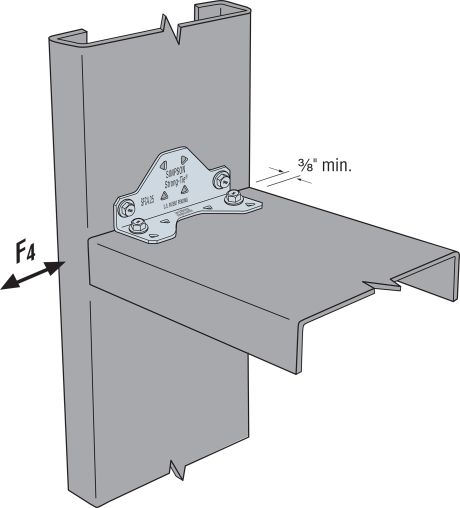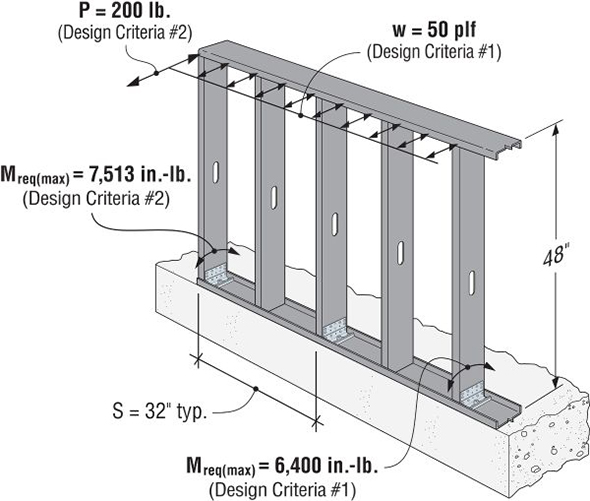I recently had the pleasure of presenting a webinar with Rob Madsen, PE, of Devco Engineering on our CFS Designer software, “Increase Productivity in Your Cold-Formed Steel Design Projects.” The webinar took place on September 28, and a recording is available online on our training website for anyone who wasn’t able to join us. Viewing the recording (and completing the associated test) qualifies for continuing education units and professional development hours. The webinar covers how to use the CFS Designer software to design complex loading conditions for beams, wall studs, walls with openings, and stacked walls using cold-formed steel studs, tracks, built-up sections, and even custom shapes. We received some excellent questions during the webinar, but due to time constraints were only able to answer a few during the live webinar. Rob and I did get a chance to answer all the questions in a Q&A document from which I’d like to share some excerpts. The complete Q&A webinar list can be accessed here, or through the online recording.
Where can I download the CFS Designer program?
Please visit strongtie.com/cfsdesigner to download a free 14-day trial version of the software or to purchase a license. Webinar attendees should check their email for a special discount code. There are different licensing options based on the number of users.
Is the price for the software an annual subscription fee or is it a one-time purchase price? Is there any maintenance cost?
There’s no annual maintenance fee or subscription fee. You pay only a one-time fee for the license. CFS Designer is based on an update-and-upgrade program. All updates to the program are free to licensed users and occur every few months to correct software bugs and add functionality. Upgrades, which include new design modules and updated code information, will require an additional purchase. Simpson Strong-Tie anticipates releasing upgrades on a two-year cycle, and the next upgrade has a projected release of early 2019. If you elect not to upgrade your version of the software, the current version you have will still work, but will not have the new upgrade features.
Is CFS Designer fully compliant with AISI S100-12?
CFS Designer is compliant with AISI S100-12. You can also access earlier versions of the AISI Specification in CFS Designer by selecting Project Settings/Code and selecting the version.
Are load inputs in ASD or LRFD? Do the load combination factors have to be applied prior to entering loads in the program? Should factored or unfactored loads be input?
The current software is all in ASD (allowable strength design). The next upgrade version will feature up to eight stories of stacked x-bracing and shearwalls, which will be in LRFD. Everything else will be in ASD. The stacked x-brace and shearwalls will be LRFD because of the ACI requirements for concrete. We will also make it much more clear in this version which input is ASD and which is LRFD.
What is a web stiffener? How would you use one at a stud, header, or jamb?
A web stiffener is typically a stud or track piece that is used to support the wall stud or joist from crippling at a point load or bearing support. There are different ways to design a stiffener at different locations. Some examples include using a cut piece of stud or track attached to the stud or using a clip attached to the beam. Essentially, a web stiffener is a member that is added to the stud to help stiffen the stud from crippling.
Does this program take into consideration the cold work of forming in the design/analysis?
Yes, per AISI the program’s Project Settings default is to include cold work of forming in the design and analysis.
We generally try to size our cold-formed members to avoid the need for web stiffeners, just to save on construction and material costs. Something that helps quite a bit with the web bending and crippling calc is the bearing length. Are there code requirements for bearing lengths, or is this simply based on how much bearing we anticipate the member to have at its supports?
There are no specific code requirements for calculating bearing length for web crippling; the calculation is usually based on engineering judgment and connection detailing to determine how much bearing there will be at the support. A reasonable bearing length may be the length of the connection clip you are using for the attachment. Since web crippling is a “bearing” phenomenon, where attachments are made through the web, provided the attachment is not isolated near a flange, you may not need to consider web crippling. For stud-to-track types of connections, it’s common to use the track leg length as the bearing length.
Does this software give any stud-to-stud connection calculation like stud tearing and shearing? Checks?
The studs are designed per the AISI code for shear, moment, web crippling, axial load, and the related code-required interactions. Net-section rupture near connections is not checked by the CFS Designer™ software.
What is the difference between flexural bracing and axial bracing?
Flexural bracing is bracing that is used to increase the moment capacity of the stud, and axial bracing is bracing that is used to increase the axial capacity of the stud. These might be the same for your design, but we have given the user the ability to designate different spacings.
Do you have recommendations for how to properly terminate bridging at the end of the wall?
We agree that termination of bracing is often overlooked by engineers and should definitely be considered in design. Accumulation of bridging forces should also be considered. AISI S100-12, D3.3 and AISI S240-15 D3.4 provide methods of estimating brace forces. Simpson Strong-Tie has provided some suggestion in our cold-formed steel typical details sheets that show our SFC clip as one method to properly terminate a line of bridging.
Can the kicker connection be used on the underside of concrete fill over metal deck?
Yes! The SJC kicker connection has been tested and code listed to support diagonal brace loads. Simpson Strong-Tie has also provided a wide range of anchorage solutions for the kicker application that include connecting to the underside of concrete fill over metal deck. Concrete over metal deck may be normal weight or sand-lightweight with f’c of 3,000 psi minimum and 2.5″ minimum slab height above upper flute. Minimum deck flute height is 1.5″ (distance from top flute to bottom flute). Please visit strongtie.com for more information and design tables.
Why do some engineers use steel posts welded to a base plate for low wall applications?
For walls that are not top-supported, some Designers use a welded steel post at a certain spacing and infill with cold-formed steel studs and a top track. Simpson Strong-Tie has developed an innovative moment-capacity connection called the RCKW rigid kneewall kit, which can support many of these same conditions using cold-formed steel studs and eliminate the need for structural steel.
Are there any plans to expand the software capabilities?
We have a long list of enhancements and additions for the software and will continue to make the software more efficient, more user friendly, and with additional design capabilities.
Thanks again to everyone who joined us for the webinar and sent us questions. For complete information regarding specific products suitable to your unique situation or condition, please visit strongtie.com/cfs or call your local Simpson Strong-Tie cold-formed steel specialist at (800) 999-5099.





